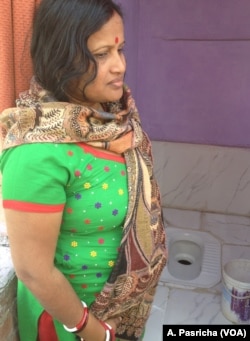In Geeta Colony, a crowded slum in the Indian capital, 45-year-old Meena Devi said she would rather walk into open areas in the vicinity of her tiny home for defecation than wait in snaking lines at the “filthy” community toilets. “The toilets are in terrible condition, there is no sewer system. Then they shut the doors at night,” she said.
Across Indian villages and towns, the government has accelerated a drive to build millions of toilets as it makes ending open defecation by an estimated 600 million people a rallying cry. Some 9 million toilets have been built since the campaign was launched a little over a year ago.
Shifting Social Norms
But sanitation experts say the campaign is faltering as many of the latrines lie unused. It is not just community toilets in festering urban slums that have discouraged people like Meena Devi from changing old habits. Tens of thousands of independent latrines built for village households are also shunned – mostly due to age-old cultural resistance to using them.
Renu Khosla at the Center for Regional and Urban Excellence (CURE), which works on sanitation issues in urban slums, said one of the major stumbling blocks in persuading people to use latrines is the type of toilets being built. Most of them use what is called a “single-pit technology.” “Now the pits fill up and pits need to be flushed out and when they are desludged, it costs money. So what happens is that people are reluctant to use. Household toilets, whether in villages or urban areas, the cost of cleaning up the pit is one major deterrent for use,” explained Khosla.
On the other hand she said, people see many advantages in open defecation. “There is no waiting time involved, you can do at your own free will or whenever it is convenient.”
Notions of purity
The government has launched a campaign to raise awareness about the risks of open defecation, which the World Health Organization say exposes people to diseases such as diarrhea, typhoid, and worm infection. Catchy advertisements on television urge rural women to shun marrying into homes without toilets, underline the health benefits and highlight how they improve security for women, who usually venture out into fields under the cover of darkness.
But sanitation experts say the message is not going home because it fails to address one of the fundamental reasons for people’s reluctance in using latrines in the country’s rural heartland – India’s centuries-old caste system and notions of purity.
Sangita Vyas, who heads the New Delhi-based Research Institute for Compassionate Economics (RICE), said although the toilets being built have been successful in many developing countries such as Bangladesh, they are failing to win acceptance in India because the pits have to be emptied manually. That task carries a deep stigma in a country where clearing away human waste was traditionally done by lower castes.
“So anyone from the middle or upper castes would consider it to be completely inconceivable to manually empty the latrine pit. And at the same time, people who have historically been tasked with handling feces, manual scavengers, they also are understandably seeking to avoid this kind of work because it is associated with past and continuing oppression,” said Vyas.
Many in villages among the higher castes also spurn latrines inside the house because they believe the presence of the toilet would make it an impure place to do “pooja” or worship God.
Success stories have been notched in areas where the toilets built do not have pits which have to be manually emptied.
Connecting to a sewer system
In the same slum in the east part of New Delhi where Meena Devi often ventures into open fields, development agency CURE helped 60 households build tiny toilets that are now connected to a sewer line. The results have been dramatic.
Poonam Sode proudly shows off a tiny latrine built in her home four months ago. It has put an end to a tortuous wait at the community toilet or a late-night visit to the fields. “I don’t have to go out of the house now. Earlier I had to wait till midnight to go into the fields to make sure there were no people around," said the delighted mother of three.
Other families in the slum are now clamoring for toilets connected to a sewer.
A report released by WaterAid on the occasion of World Toilet Day last November said that if all people without toilets in India stood in line, they would stretch from the Earth to the Moon.
While the government has won praise for drawing up goals to build enough toilets to end that line by 2019, Khosla at CURE said it will only happen if more stress is laid on simple engineering solutions. “It is important for us to make the connection, it is important for us to recognize that it’s not just about putting the superstructure for a toilet, it’s also about the sewage management. That’s critical as well.”












